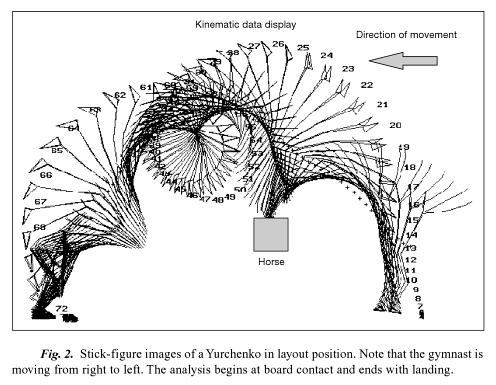For my Biomechanics class, I had to find and select a biomechanics expert and report on his work. Biomechanics? Motions of the body? Gymnastics. For more than 9 years – that is to say most of my childhood – I trained as a gymnast an average of 15 hours per week. By the end of my “career”, I was far from reaching the Olympic level, but could proud myself on winning the provincial competition, doing the same type of skills performed by my idol of the time, Nadia Comaneci. This assignment brought me for the first time to a scientific analysis of movements and skills I performed as a kid, not understanding how complex there were. I discovered a whole field of research I never thought I applied myself.
Dr. Sands is the author of many publications on biomechanics of gymnastics. He contributed to the building of a biomechanics semantics specific to this sport of high physical performance with the merit of the athletes based on the subjective perceptions of judges. Sands and his research team have used biomechanics to build an objective way to score the performances of the athletes. They used video digitizing, infrared timers, and a computer algorithm to build a scientific understanding of the skills performed.
Sands finds that the science of analyzing gymnastic with biomechanics is hard due to the rapid evolution of the sport: “Due to the constant progress of gymnastics skills and the skill specificity of biomechanical analyses, any biomechanical summary will be constrained by the timing and contemporary state of gymnastics performance” (1). The apparatus characteristics constantly change and bring a variety of skills. It is a challenge to apply the knowledge of the science to a discipline using tools that are external to the body – unlike diving for instance. Dr Sands studies the impacts of the technical developments of the apparatus on the gymnasts performances and bodies. Here is a video showing the analyze of a certain type of spring floor.
His researches show that on the vault per example, that contrarily as we might think, the velocity and score of a gymnast performance is not so much based on the speed of the run-up towards the vault. It depends more on the transition she makes in between the run-up and the take-off board doing a really simple move, the hurdle. It is in the ability of the gymnast to control the slowing down of her speed rather that the speed itself. You can see here the vault performances of the London 2012 Olympics. Here is the schematic of a yurchenko.
My understanding of Sands work is that his analyses of the gymnastics skills have helped coaches and athletes perfecting their approaches. He has contributed a lot to the understanding of how the speed and motion of every skills can be deconstructed in small parts and thus improved by focusing on the specific gesture or timing that will push to gymnast towards perfection, and, very important to him, less injuries. Paradoxically, biomechanics of gymnastics is a complex field because of the sport constant improvements, that are mainly die to the application of biomechanics to the sport.
Here is a video (very old school) demonstrating some basic analyses of skills using a biomechanical approach.
(1) W. A. Sands in W. A. Sands, D. J. Caine, J. Borms : Scientific Aspects of Women’s Gymnastics, Medecine and Sport Science, Vol. 45 page 6.


I was cruising the internet and I stumbled across this web page. I know you are beyond to bigger and better or at least other things but I have always related the kinesiology aspect of gym skills to object oriented programming of computers. Each skill has properties and methods within to ultimately give different results per object execution. Obviously each skill has properties like flips per sec and feet per sec but do you see any value in creating hybrid properties like flips per foot for optimum performance per skill.
just curious if I get a response.
Gary Jeurink